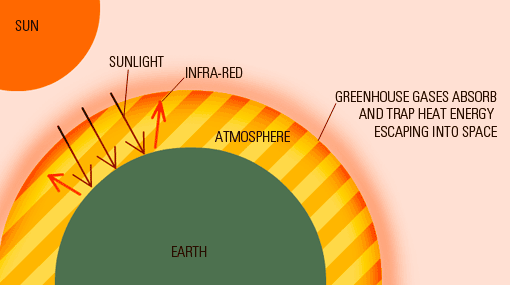If you park your car outside on a hot sunny day with all the windows up, what happens? You notice it is very hot inside. That is simply because some of the heat energy from the sun that got into it by radiation could not escape because of the closed windows.
The earth’s atmosphere works in a similar way. The atmosphere is a blanket of gases that help regulate the earth’s surface temperatures. Typically the atmosphere is a mixture of gas molecules and some particles together called air. Some of these gases include nitrogen (78%), Oxygen (21%), Argon (.9%) and water vapor, carbon dioxide and a couple more making up the rest. It also contains lots of solid particles of dust, soot, pollen and other pollutants.
When sunlight reaches the earth’s surface, in the form of infra-red rays, some of it is absorbed by objects on the earth’s surface, particularly large water bodies, vegetative and land cover. Some of it is also reflected back into space.

Naturally, life on earth depends on heat energy, and it is believed that the atmosphere, with its natural greenhouse components, help maintain this average temperature of about 59 degrees Fahrenheit (15 degrees Celsius). Somehow, an increase of greenhouse gases in the atmosphere, largely as a result of human activity, has altered this natural balance in a very interesting way. How is this? Most of the escaping heat energy (about 90% (NASA, A blanket around the earth) is absorbed by these greenhouse gases and re-emitted in all directions. This means there is more heat energy trapped in the atmosphere than ever before. The heating effect resulting from the action of excess greenhouse gases is what is known as the ‘greenhouse effect’
Radiative Forcing
There is a natural balance between the incoming solar radiation and outgoing infra-red radiation from the earth. The measure of the forced change or stray-away from the natural equilibrium is what we call ‘Radiative Forcing’
